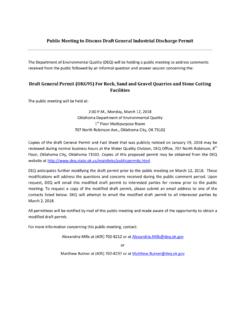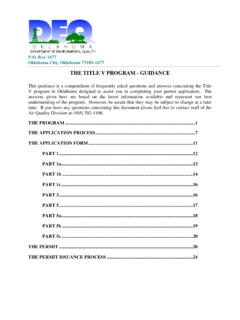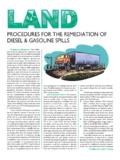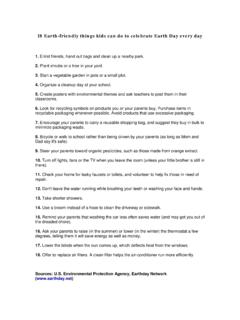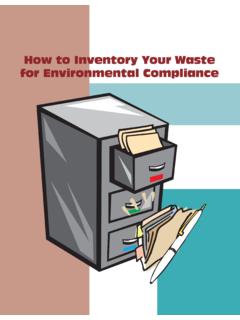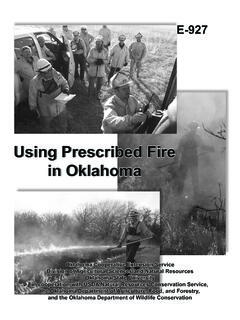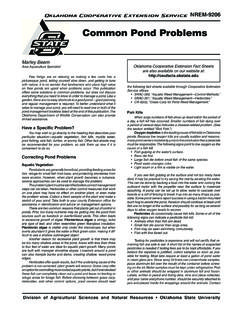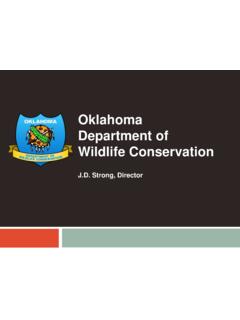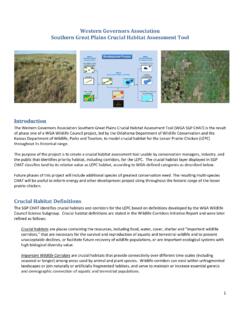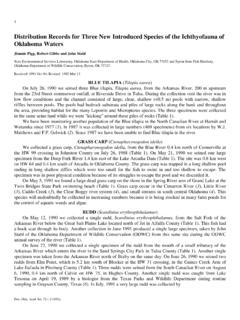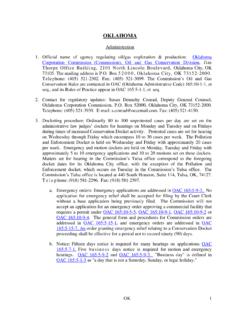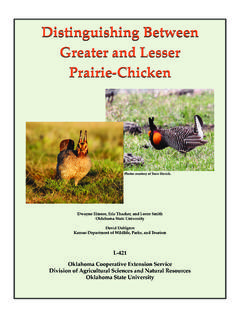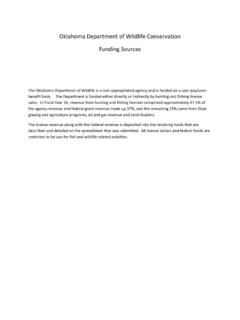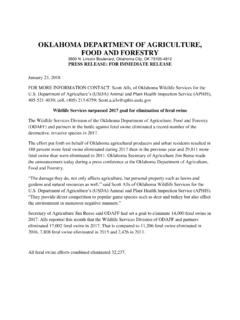Transcription of Exhibit 1 - Endangered Species - Oklahoma Department of ...
1 Exhibit 1 - Endangered Species The list of Federal and Oklahoma Sensitive waters and watersheds, which are harboring Endangered and threatened Species and their critical habitat, can be found in ADDENDUM A. Also, a map is included showing the general location of these waters and watersheds. A. Background The DEQ is seeking to ensure the activities regulated by this Permit are protective of Endangered and threatened Species and critical habitat. To ensure that those goals are met, owners/operators seeking Permit coverage are required under Part to assess the impacts of their storm water discharges and storm water discharge-related activities on identified Endangered and threatened Species and designated critical habitat. This may be accomplished by following the procedure below. DEQ strongly recommends that you follow these steps at the earliest possible stage to ensure that measures to protect listed Species are incorporated early in the planning process.
2 At minimum, the procedures should be followed when developing the Storm Water Pollution Prevention Plan (SWP3). You have an independent obligation to ensure that your activities do not result in any prohibited take of listed Species . Many of the measures required in the Permit and in these instructions to protect listed Species and their critical habitat may also assist you in ensuring that the operations at your facility do not result in a prohibited take of a Species . If you are located within the area of Federal and State sensitive waters and watersheds you must meet the requirements of Step 2. If it is not possible to meet those requirements or if you determine that your discharge or activities will result in unacceptable effects on listed Species , you should apply for an individual permit. This permit provides for the possibility of multiple industrial facilities in the same vicinity.
3 You should be aware that in some cases you may meet the permit eligibility requirements by relying on another permittee s certification of eligibility. However, the other permittee's certification must meet the permit eligibility requirements and address the effects from your storm water discharges and storm water discharge-related activities on listed Species and critical habitat. By certifying eligibility, you agree to comply with any measures or controls upon which the other operator's certification was based. This situation will typically occur where one industrial facility conducts a comprehensive assessment of effects on listed Species for that entire site, certifies eligibility and that certification is relied upon by other owner/operators in the vicinity. However, if you consider relying on another operator's certification you should carefully review that certification along with any supporting information.
4 If you do not believe that the other operator's certification provides adequate coverage for your storm water discharges and storm water discharge-related activities for your particular industrial facility, you should provide your own independent certification. In situations where an operator goes through the Endangered Species Act (ESA) process and obtains an authorization for storm water discharges, then later sells the facility, the new owner can then rely on the previous ESA eligibility analysis if they choose and avoid needing to repeat the process for the same facility. It is also possible there could be a situation where a "developer" gets clearance for an industrial park and the tenants that move in might be able to rely on the original ESA evaluation depending on the scope of activities considered. B. Procedures To receive coverage under the MSGP, you must assess the potential effects of your storm water discharges and storm water discharge-related activities on listed Species .
5 To make this assessment, follow the steps outlined below prior to completing and submitting a Notice of Intent (NOI) form. Step 1: Determine Whether the Facility is Located in a Sensitive Water or Watershed. 1. Refer to the map of Federal and State sensitive waters and watersheds within Oklahoma . These areas may harbor populations of federal or state listed Species or their designated critical habitat. 2. If your industrial facility is not located within any of these areas, the facility s storm water discharge or storm water discharge related activities are not likely to significantly affect Endangered and threatened Species . You may then skip Step 2 and further investigation is unnecessary. 3. If your facility is located within the area of any of the Federal and State sensitive waters and watersheds, continue on to Step 2. Step 2: Implementation of Storm Water Control Measures to Protect Endangered and Threatened Species : 1.
6 If your industrial facility is located within the area of Federal and State sensitive waters and watersheds, you must incorporate the following measures into the SWP3 for the facility. a. Pollutants such as oil, grease, solid waste, human waste, hazardous or toxic material, or other material not authorized for discharge under this permit must be properly captured, treated, and correctly disposed of. These potential pollutants must be properly managed and their contact with storm water minimized or eliminated to the greatest extent practicable. b. If you are required to perform annual numeric effluent limitation monitoring you must include in your SWP3 the steps you will take to prevent any removed pollutants from entering a storm water stream. These pollutants must be retained on site, treated, or disposed of properly to the greatest extent practicable.
7 Control measures must be properly installed and maintained at all times, and off-site accumulations of any escaped sediment must be removed. c. A schedule must be included which describes the inspection practices that will be used to ensure that control measures are working effectively. Monthly inspection shall be conducted for areas of the facility with significant activities. d. Hazardous materials and production waste products must be stored in a manner that minimizes their contact with storm water. An emergency response plan must be included which addresses the handling of accidental spills or leaks. 2. You must comply with any terms and conditions imposed under the eligibility requirements to ensure that your storm water discharges and storm water discharge-related activities are protective of listed Species and/or critical habitat. Any such terms and conditions must be incorporated in your SWP3.
8 In accordance with Part of the permit, your signed NOI will be deemed to constitute your certification of eligibility. If the eligibility requirements cannot be met, you may seek coverage under a DEQ individual permit. Step 3: Check the appropriate box on the NOI Form. There are three different options to certify your eligibility. Check the box that corresponds to the option on which you are relying. a. Your municipality is not located in Federal and State sensitive waters and watersheds as identified on the map. b. Your facility is located in Federal and State sensitive waters and watersheds and you agree to implement the control measures specified in Step 2 above. c. You are relying on another permittee s certification of eligibility and agree to comply with any conditions attached to that certification. Step 4: Submit a Complete SWP3 to the DEQ for Review with your NOI Form You must submit a copy of the complete SWP3 to the DEQ for review with your NOI form if your facility is located within the corridors/areas of Federal or State sensitive waters and watersheds (also see the following map in Addendum A).
9 When your SWP3 is reviewed by the DEQ, the DEQ can require you to amend the plan if it does not meet the minimum permit requirements. 3 ADDENDUM A Oklahoma Sensitive Waters and Watersheds Harboring Endangered and Threatened Species and Their Critical Habitat of Concern A. Sensitive waters and watersheds for Federally listed Species , as defined by the Fish & wildlife Service for the DEQ industrial storm water permit Grand (Neosho) River - A two-mile corridor (one mile from each bank) of the main stem of the Grand (Neosho) River above its confluence with Tar Creek. Includes portions of Ottawa and Craig Counties. Arkansas River - A two-mile corridor (one mile from each bank) of the main stem of the Arkansas River between the Oklahoma /Arkansas state line and the Kaw Reservoir dam (excluding the flood pool or Keystone Reservoir). Includes portions of Sequoyah, Haskell, LeFlore, Wagner, Muskogee, Tulsa, Osage, Pawnee, Noble and Kay Counties.
10 Cimarron River - A two-mile corridor (one mile from each bank) of the main stem of the Cimarron River from the flood pool of the Keystone Reservoir upstream to and including Beaver County. Includes portions of Creek, Payne, Logan, Kingfisher, Major, Woods, Woodward, Harper, and Beaver Counties. South Canadian River - A two-mile corridor (one mile from each bank) of the main stem from the confluence with the Arkansas River (excluding the Eufaula Reservoir flood pool) upstream to the Texas state line, and the river segment in Haskell, McIntosh, Pittsburg, Hughes, Pontotoc, Seminole, Pottawatomie, McClain, Cleveland, Canadian, Grady, Caddo, Blaine, Custer, Dewey, Ellis, and Roger Mills Counties. Muddy Boggy River - A two-mile corridor (one mile from each bank) of the main stem of the Muddy Boggy River. Includes portions of Choctaw, Atoka, and Coal Counties. Kiamichi River The watershed of the Kiamichi River upstream from the Hugo Reservoir.
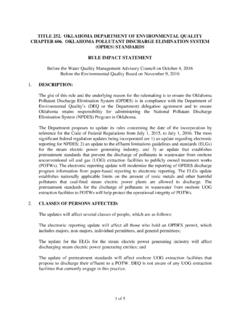
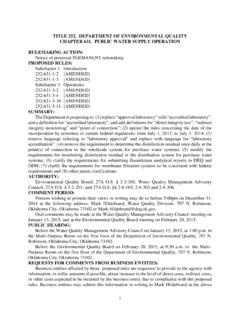
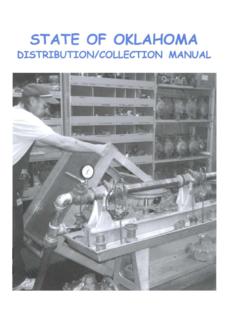
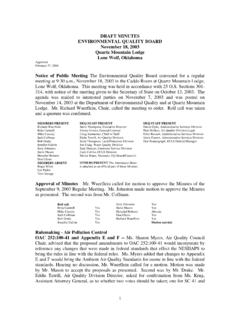
![[NOTICE OF RULEMAKING INTENT] - Welcome to …](/cache/preview/0/e/b/1/6/4/5/2/thumb-0eb16452057ea1b264c252307d7f8015.jpg)
